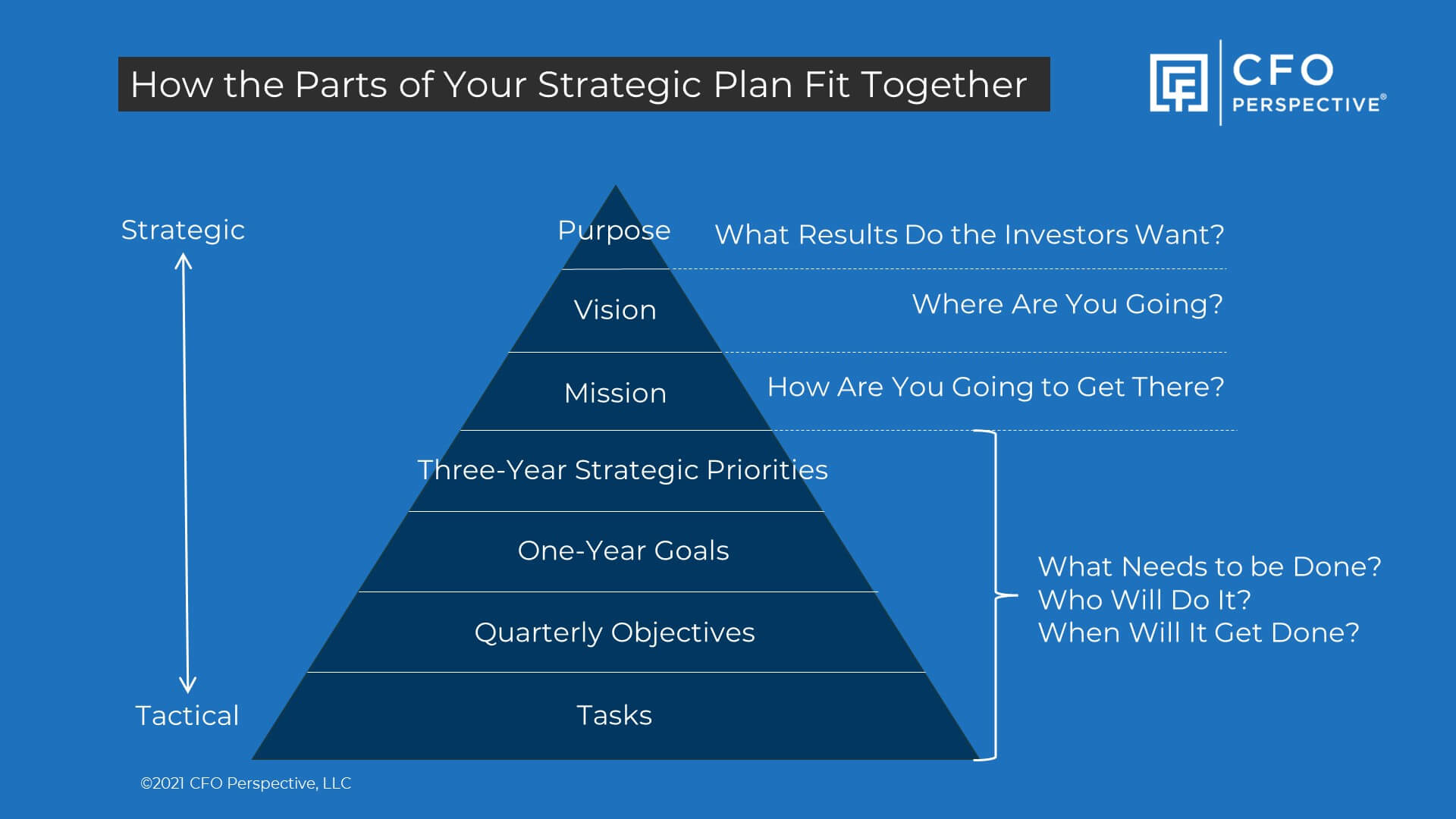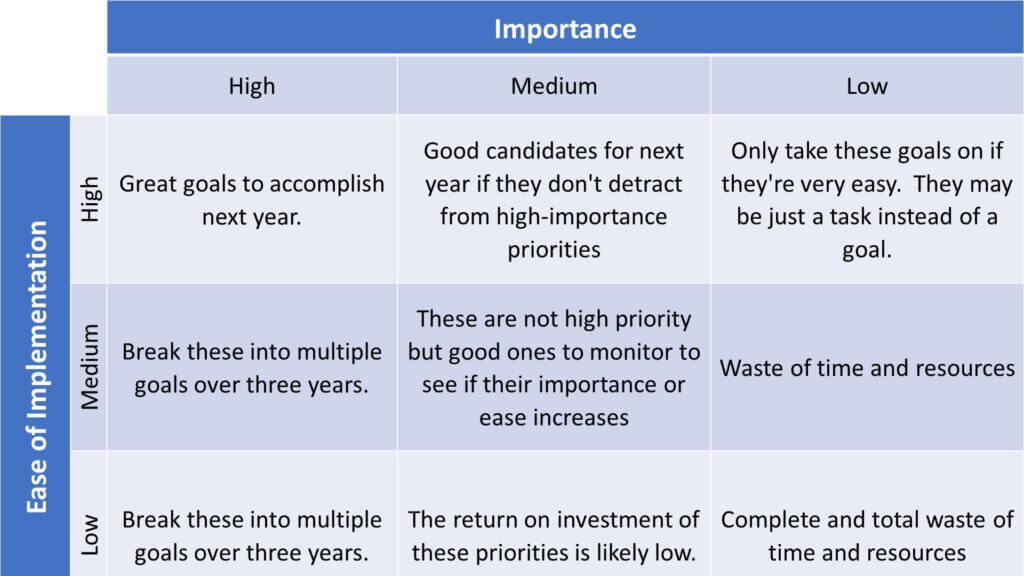Skip the overkill of most strategic planning to focus on where you are going and how you are going to get there. You only need enough detail to make the right decisions.
Did you ever notice that both strategic planning retreats and horror movies are stories about a group of people trapped in a cabin in the woods where they are slowly dying? There’s a lot of overkill in most strategic planning. You don’t have the time or resources to waste on complex strategic planning. What you need is a strategic planning process that fits your business.
Small business strategic planning doesn’t have to be complex. The definition of strategic planning is determining where you’re going and how you’re going to get there. That’s really all there is to it.
What makes your strategic plan effective is how it helps you make the right decisions. Your strategic plan sets the boundaries and guidelines for all your tactical decisions. It’s your criteria for success.
Let’s break that down into concrete steps. You can do it in four steps:
Strategic Planning for Small Businesses
- Purpose – Why do you own this company?
- Vision and mission – Where are you going, and how are you going to get there?
- SWOT – What is your current reality?
- Three-year priorities, one-year goals, quarterly objectives – How will you get from your current reality to your vision?
Here’s how it looks visually:
 I’ll walk you through each step.
I’ll walk you through each step.
Purpose: Why Do You Own This Company?
As a small business owner, the purpose of your business starts with your purpose for your life. That sets the direction so you don’t get lost. Strategic planning for your company begins with your personal aspirations and plans.
You own your company to serve you and not for you to serve your company. This is not at the exclusion of serving your customers or employees. I explain in How Does Value Creation Lead to Business Success? how you get value when you give value. Your business will only succeed if you provide great value to both your customers and employees.
If you don’t define what you want, your company will wander until you wake up one morning and realize you are working for a company you hate – and it’s your company.
Before you write that off as impractical fluff, let me give you some specific, very practical examples of what I mean:
• Are you building this business to own for a long time, or are you maximizing value in the shorter term to build it for sale? You make totally different infrastructure investments and tax planning depending on your answer.
• Do you want to maximize your earnings, or do you want a company that gives you time and cash for pursuits outside the business?
• Do you want total control of your company, or do you want partners that can provide experience, cash, or other resources?
Every business has to ask, “What do the owners want?” and then deliver on that. Companies that don’t either fail or are sold because they didn’t deliver what the owners wanted.
How do you clarify your purpose? I wrote an article titled “Business Goals Move You From Distraction to Direction” that walks you step-by-step on how to do this.
This doesn’t need to be complicated. You just need to be clear about the one or two main things you want from your company based on your plan for your life.
This may mean defining what you want from a financial planning perspective. It may mean defining how much time you want to spend in the company. You may get a high amount of satisfaction from your clients, your employees, or what your company does for your community.
Vision and Mission: Where Are You Going and How are You Going to Get There?

Large companies can spend countless hours and dollars developing vision and mission statements. My guess is that you already have a decent idea of where you want your business to go and how you’re going to get there. If that’s the case, building a vision and mission statement is easy.
A vision statement is a short summary of what you want your company to look like in 5-10 years. It explains how your company will support your personal aspirations. A mission statement is a short summary of how your company will achieve that vision. Specifically, it states who your company serves and what it does for them.
Having a clear vision and mission:
- Defines the future direction of the business
- Guides strategic planning, budgeting, and decision-making.
- Inspires employees
- Focuses everyone on one common big goal
- Stretches the company beyond its current capabilities
- Defines expectations of employees
- Clarifies how the company will support the owner’s personal aspirations
- Clarifies the purpose of your company so that you can clearly communicate it to customers and employees.
- Provides focus for the company.
This will lead to:
- Higher productivity
- Improved employee morale and lower turnover
- Easier recruitment of new employees that are the right fit for your company
- Easier and more efficient planning
- Less conflict in strategy and execution
- More effective and efficient marketing
Do you, your customers, and your employees clearly know the goal of your company (i.e., where it’s headed) and how you are going to get there? That’s what a mission and a vision statement provide. You may have never considered how powerful that would be for marketing to customers and to guide employees. I go into this more in my article titled How Does Value Creation Lead to Business Success?.
Here’s an example of a vision and mission statement from Southwest Airlines:
- Vision statement: To become the world’s most loved, most flown, and most profitable airline.
- Mission statement: The mission of Southwest Airlines is dedication to the highest quality of customer service delivered with a sense of warmth, friendliness, individual pride, and company spirit.
Southwest likely spent lots of time and money picking and testing each word. Spend as much time as you need, so your vision and mission are clear. It doesn’t have to sound pretty; it just needs to be clear to guide your decisions. You may decide to polish it a little more if you want to communicate it to your employees or customers.
Vision and Mission Set Boundaries

Purpose, vision, and mission are crucial. One of my favorite quotes is, “When your vision is clear, the decisions are easy.” Defining your purpose, vision, and mission will create the boundaries for all the decisions that follow.
For example, I was the CFO of a community health center that also provided transitional housing. The mission of the company said nothing about transitional housing. That was a need in the market the company had decided to help address.
The transitional housing was a constant distraction from our core healthcare mission. We decided to exit transitional housing so we could focus on our core mission.
Many people don’t think they need a strategic plan because they know what they need to do. What they don’t have is clarity on what they shouldn’t do.
Your strategic plan says what you will focus on, so it’s clear what you won’t do. Many people don’t think they need a strategic plan because they know what they need to do. What they don’t have is clarity on what they shouldn’t do. These are the things that will distract them and cause them to be unfocused and inefficient throughout the year. Worse, they could cause a massive shift of resources away from a better investment.
Your current reality: SWOT Analysis
Now it’s time to get honest. Your company has a long way to go to achieve your vision for it. We’ll get into the steps to get to that vision later. For now, you need to know where you’re starting from to know the path you need to take to get where you want to go.
A time-tested way to do this is a SWOT analysis. SWOT stands for strengths, weaknesses, opportunities, and threats. You look inward at your company to assess your strengths and weaknesses. You look outward to your competitors and business environment to discover your opportunities and threats.
It’s simple but powerful. I go into detail on how to conduct a SWOT analysis in What is SWOT Analysis? Simple but Effective Business Environment Assessment.
Three-Year Strategic Priorities
No company has enough resources to accomplish everything it wants. Setting priorities is about focusing your scarce resources on the things that matter most.
How do you know what matters most? Your purpose, vision, and mission set the general direction. It’s time to choose exactly what steps you need to take to get there.
Most business owners plan strategically just a year or less in advance. This is a mistake. Yes, your tactics are constantly changing. However, your dreams for your company are too big to be achieved in a year. Your strategic plan is a multi-year outline of how you’ll achieve those dreams.
Setting priorities and goals determines both what you will do, what you may do, and what you will not do. Not taking the time to identify your strategic priorities creates massive inefficiency for your company.
Your three-year priorities, one-year goals, and quarterly objectives all break your broad mission into actionable steps. All these pieces work together to flow from the strategic to the tactical. Each provides more detail to the second part of the definition of small business strategic planning, which is “how you are going to get there.” Below are examples and criteria for strategic priorities.
Example strategic priorities
- Improve customer value and loyalty
- Improve operational processes
- Eliminate cash drains and improve cash creators
- Find new markets or customers for products or services
- Expand products or services
- Reduce operational costs
Criteria for good priorities:
- Achieves your vision via your mission.
- Clear and easily understood by those who will need to implement it
- Makes a long-term strategic difference for the business. This is not a list of easy-to-accomplish tasks.
- Realistic but may stretch the organization to achieve it.
- Inspiring
- Usually requires a significant investment of time, money, or other resources
There is no one right way to set your priorities. I explain four methods in 4 Proven Ways to Prioritize Your Goals and Tasks.
One Year Goals

Your three-year strategic priorities identify the broad priorities for your company. Your one-year goals state the specific areas of focus for the next year. Further, these goals have metrics tied to them to define success and track progress.
These goals are communicated to everyone in your company so all your employees are clear on their priorities for the current year. The metrics provide accountability for reaching the goal. Some good candidates for one-year goals are:
- Next steps in a large set of steps to achieve a strategic priority: Think through the major steps of your strategic priorities. Identify what steps must happen over the next year for you to achieve your strategic priority in three years.
- High importance: High-priority items are good choices for one-year goals so you can capture the benefits as soon as possible.
- Easy implementation: Items that have a moderate impact but are easy to implement can provide a good return on investment for you. It’s OK to have a few of these for goals but never sacrifice importance for ease. Having too many of these as goals can distract you from achieving your most important priorities.
- And finally… last year’s goals that weren’t completed: It happens. You get to the end of the year and realize that some goals aren’t going to get done. Now is the time to refocus on getting those goals accomplished to refocus your company’s resources on new goals.
Selecting goals is a balance between what’s important and what’s easy to implement. The table below summarizes this:

What’s a good goal?
A classic acronym for good goals is SMART:
- Specific: Clear to everyone
- Measurable: Objectively defines success and track your progress
- Attainable: Achievable, even if it’s difficult
- Relevant: Makes progress toward your vision and priorities
- Time-based: There is a final completion date and milestone dates for progress
What are the components of a goal?
- Deadline: This addresses the time-based aspect of the SMART acronym. Goals without deadlines never get done.
- Accountability: Assign primary responsibility to one person. When more than one person is accountable, no one is accountable.
- Metrics: Goals are measurable when they have at least one objective metric. Metrics monitor the outcomes from tasks, not the completion of tasks. Deadlines monitor task completion.
- Targets: Metrics are what you are measuring, and targets are the metric value that you are trying to achieve
Quarterly Objectives and Tasks
Quarterly objectives help you:
- Overcome feeling overwhelmed: Quarterly objectives break down the one-year goals so they don’t feel so overwhelming. I know what it’s like to stare at a new set of one-year goals and take a big gulp.
- Further focus and prioritization: When everything is a priority, nothing is a priority. Some steps need to happen before others. These steps need to be put in order. Planning quarterly objectives identifies what’s important now and what will happen later.
- Company alignment and accountability: These goals will be communicated to everyone in the company. All your employees should know the company’s priorities and how the company plans to meet its one-year goals. Communicating who is responsible for each objective also creates accountability.
What is a good objective?
- SMART: Like SMART goals, SMART objectives are more effective.
- Defines outcomes: Leaders set the outcome for the objective. People assigned to the objective will develop the tasks on how to achieve the outcome.
- Single major step: Some of the annual goals can be accomplished in one quarter and so transfer directly into one objective. Other annual goals require multiple steps to accomplish the goals. In Measure What Matters, John Doerr notes, “unacknowledged dependencies remain the number one cause of project slippage.” For every goal, think through if there are major steps that need to be accomplished before another step can be accomplished.
- Only 3-7 per quarter: Your company has limited capacity. Setting too many objectives is overwhelming and demoralizing. Setting a limited and balanced set of objectives each quarter paces the company and gives staff a better chance of achieving each goal.
- Start and End Date: Set the date you expect the work on the objective to start and when you want the objective accomplished. You may need to consult with the person who’s assigned to this objective to determine these dates. The person the objective is assigned to will build a more detailed timeline.
- Assigned to: One-year goals should always be assigned to the top leaders of the company, but objectives may be assigned to other staff. Whoever is assigned an objective is accountable to whoever was assigned the goal the objective supports.
Two popular ways to measure and manage your goals and objectives are:
- Objectives and Key Results (OKRs)
- Key Performance Indicators (KPI) Dashboard
The Final Check: Cash Flow Projection

You determined your priorities for the next year and set targets with your one-year goals. Your quarterly objectives created the timeline of when you will work on goals or major steps towards reaching those goals.
The cash flow projection takes all that information and translates it into cash flow. This is a great reality check for your goals. You may find that the investments you planned for the next year stretch your cash beyond its limits. This gives you time to find the funding you need.
Insights from the cash projection will allow you to make further refinements to your goals and objectives. Strategic planning is not a linear process where big ideas flow neatly to details. It’s an iterative process where you constantly refine earlier steps based on the information you gain in later steps. All the parts of the process need to be flexible so they form an integrated plan at the end.
What is Strategic Planning? Your Definition of Success and Your Path to Achieving It
I’ve given you lots of details and resources on how to build your strategic plan. Just to make sure you’re not lost in those details, here are the four steps:
- Purpose – Why do you own this company?
- Vision and mission – Where are you going, and how are you going to get there?
- SWOT – What is your current reality?
- Three-year priorities, one-year goals, quarterly objectives – How will you get from your current reality to your vision?
For more info, check out these topics pages:
